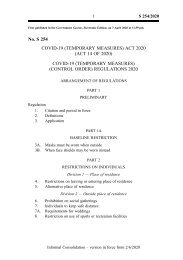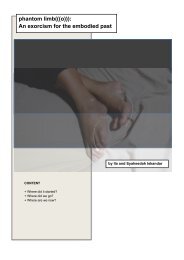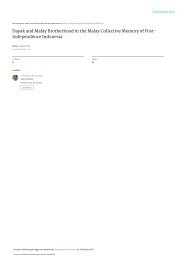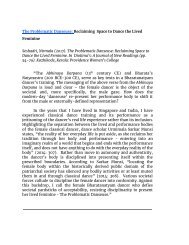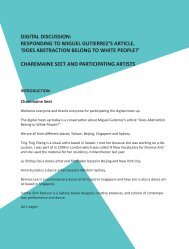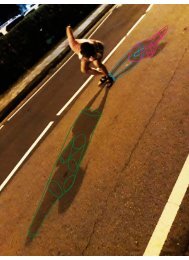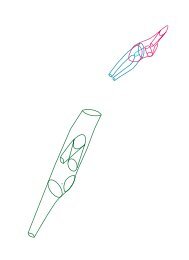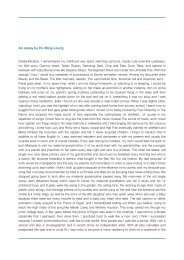FUSE#5
This edition of FUSE consists of articles contributed by artists who participated in Dance Nucleus' programmes in 2020.
This edition of FUSE consists of articles contributed by artists who participated in Dance Nucleus' programmes in 2020.
Create successful ePaper yourself
Turn your PDF publications into a flip-book with our unique Google optimized e-Paper software.
FUSE #5<br />
the dance was also that of colonialism leading to post-independence. There<br />
is a great amount of writing on this era by scholars including Amrit Srinivasan<br />
(1985), Anne Marie Gaston (1996), Avanthi Meduri (1996), Uttara Coorlawala<br />
(2004), Janet O’Shea (2007) and Teresa Hubel (2005).<br />
13. See for example Amrit Srinivasan: The Tamil Bhakti tradition of which the<br />
Devadasi was an integral part, rejected Puritanism as a valid religious ethic for<br />
its female votaries” (1876), Balasaraswati: “There is nothing in Bharatanatyam<br />
which can be purified afresh” (1978: 110), Ram Gopal: “Rukmini…has bleached<br />
Bharata Natyam…we worship the linga [male sex organ] and the yoni [female sex<br />
organ]… How can we deny sex between a man and woman? How can you not<br />
feel that erotic drive? It is a charge between human beings.” (In Gaston 1996:<br />
94), Chandralekha: “The basic aramandi [half sitting] posture, legs spread eagled<br />
with the yoni [vagina] as the centre of the universe, is so elemental, sexual. How<br />
can dance be sanitized?” (Mehra 1998).<br />
14. The reform and revival of Bharatanatyam were very much situated in the wider<br />
nationalist discourse of reform and revival of the position of women in society.<br />
While reformists were aligned with the forces of colonialism and the “European<br />
ideals of equality”, the revivalists emphasized the importance of “orthodox Indian<br />
Hindu culture” (O’Shea 2007: 105). Out of these opposing forces emerged the<br />
notion the “new respectable lady” (ibid) who would straddle both tradition and<br />
modernity. This new image of Indian womanhood percolated into the reconfigured<br />
Bharatanatyam.<br />
15. It is a noted arts and cultural institution in Chennai founded in 1926 by Rukmini<br />
Devi Arundale.<br />
16. The style of dance that was practiced in the royal court of Thanjavur and known<br />
to be fluid and abhinaya-focused with a special emphasis on sringara.<br />
17. A 17th century Telugu poet and Carnatic music composer whose compositions<br />
are performed by Bharatanatyam and Kuchipudi dancers.<br />
18. It is a traditional Indian male garment, an unstitched piece of cloth that is tied<br />
around the waist and legs.<br />
19. A dance that involves striking small sticks and is linked to the traditional story<br />
of Krishna in which he dances with the gopis (cowherdesses). The dance is performed<br />
in a circle to signify the eternal dance of life.<br />
20. An aspect of the male Hindu deity Shiva who is worshipped as the lord of dance.<br />
21. Jathi (a rhythmic metrical sequence) that is performed in three speeds.<br />
22. A rhythmic piece that is generally the opening piece in a Bharatanatyam recital.<br />
23. It refers to Non-Resident Indians.<br />
24. A term coined by historian Eric Hobsbawm to describe: “a set of practices,<br />
normally governed by overtly or tacitly accepted rules and of a ritual or symbolic<br />
nature, which seek to inculcate certain values and norms of behavior by<br />
repetition, which automatically implies continuity with the past. In fact, where<br />
possible, they normally attempt to establish continuity with a suitable historic<br />
past” (1995: 1).<br />
References<br />
Allen, Matthew Harp. “Rewriting the script for South Indian dance”. TDR (1988–) 41. 3.<br />
(1997): 63–100. Print.<br />
Balasaraswati. “On Bharata Natyam”, Dance Chronicle, 2. 2. (1978): 106–116. Print.<br />
123




